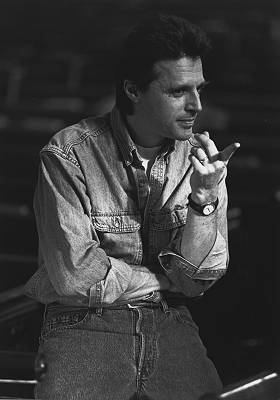|
<< -- 3 -- Lawrence Budmen GLISTENING QUALITY

The American composer Peter Lieberson (born 1946) is a practicing Buddhist. Buddhist thought permeates many of his scores. The 1986 mini-symphony Drala (composed for Seiji Ozawa and the Boston Symphony Orchestra) marked a turning point for the composer. Like many composers of his generation Lieberson had been trained by teachers who championed the atonal doctrine of Arnold Schoenberg. His early works (including the highly successful Piano Concerto written for Peter Serkin) were reverential to that idiom. With Drala Lieberson abandoned serialism to embrace the entire spectrum of compositional techniques. As an orchestrator, Lieberson's gifts are of the spectacular variety! (Lieberson is the son of the legendary recording producer and executive Goddard Lieberson and the actress-ballerina Vera Zorina. He is married to the renowned and widely versatile mezzo-soprano Loraine Hunt Lieberson.)
Drala (a meditation piece) is a lushly conceived soundscape. In the opening Invocation, figurations of woodwinds, harp, piano, and percussion lead to a series of ravishing, spacious chords in the strings -- a depiction of a solemn Buddhist procession. The percussive Gathering movement features harsh sounds from the brass -- a kind of wild celebration. The tranquil calm of the third movement, 'Offerings and Praises', comes as a striking contrast. A darkly ruminative cello solo forms the main thematic material of the movement. This daunting, darkly astringent music was played in a superlative manner by cellist Marilyn De Olivera (a graduate of Indiana and Rice Universities). Her beautiful, rich tone and innate musicality captured the music's prayerful gravity. This central movement -- the heart of Lieberson's score -- concludes with a modern day Bach chorale in the winds and a restatement of the stately, sonorous string chords from the opening procession. The score's finale -- 'Raising Windhorse' -- is indeed a wild ride. Driving counter rhythms and combustible energy seem to explode in the entire orchestra. The influence of Stravinsky's Le sacre du printemps is evident in the unrelenting rhythmic thrust and brilliant orchestration. Certainly Lieberson has written a virtuosic orchestral showpiece with some lovely, moving moments of repose.

Peter Lieberson. Photo © George Georgakakos
|
Ever the fervent advocate of contemporary music Tilson Thomas led a highly charged account of Lieberson's daunting score. The gorgeous string playing in the processional episodes was staggering. The kinetic energy of the 'Raising Windhorse' finale was a dazzling display of orchestral brilliance. The dynamic playing of the large percussion contingent was a standout. Tilson Thomas's relentless, high energy conducting gave Lieberson's score a Technicolor interpretation. The New World Symphony players covered themselves with glory!
Continue >>
Copyright © 31 October 2004
Lawrence Budmen, Miami Beach, USA

|

